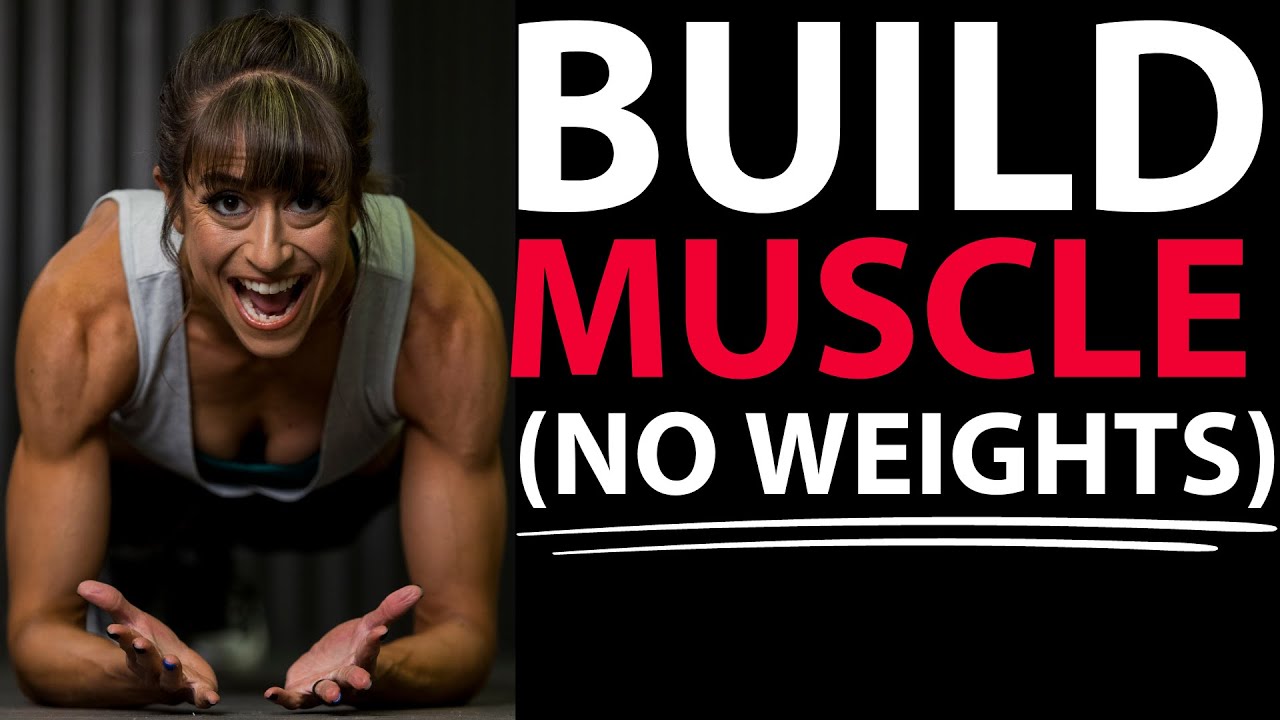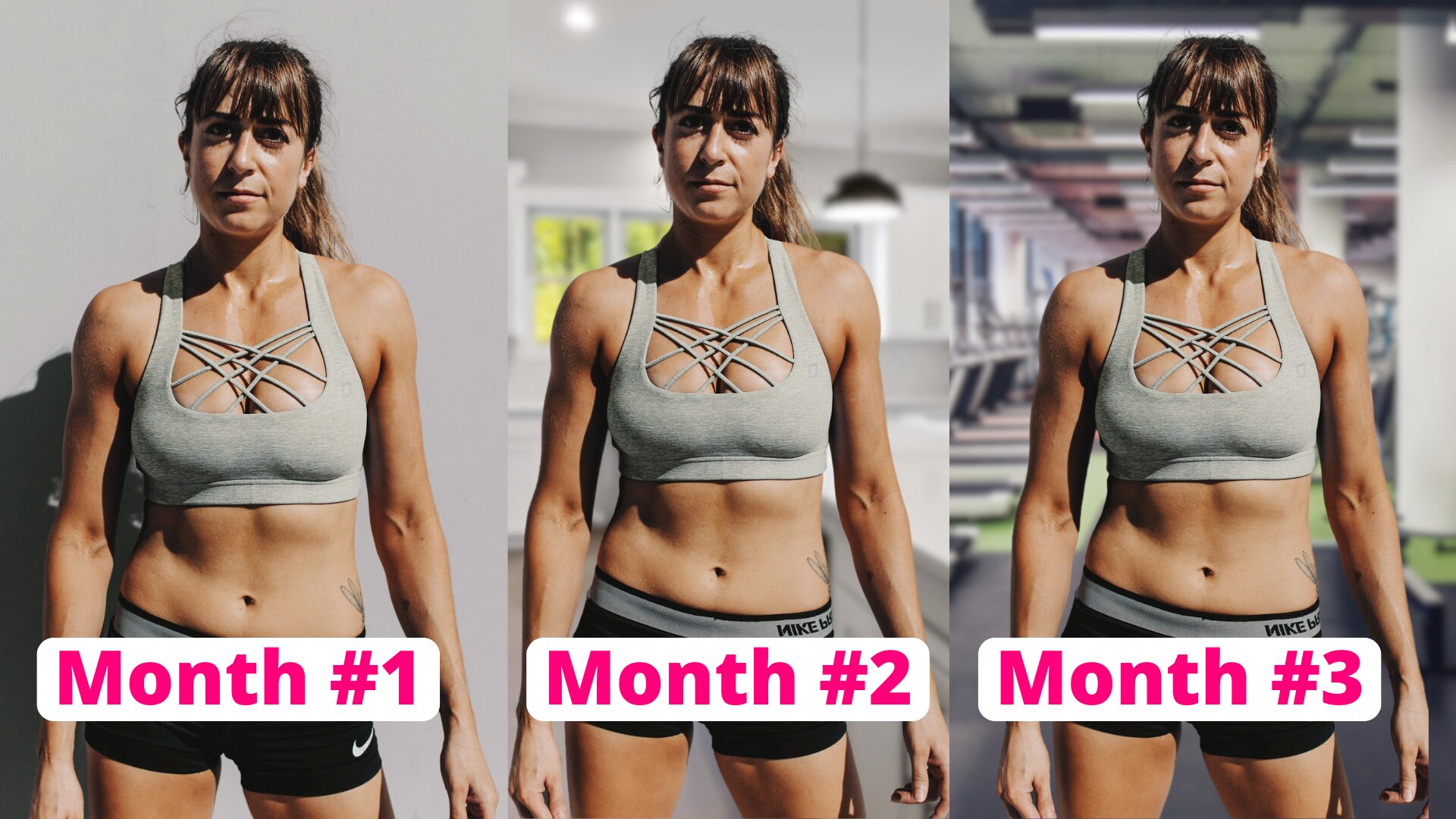You need weights to build muscle.
False.
You don’t.
While adding heavier loads can make it easy to create that progression and challenge your muscles to improve your muscle hypertrophy or muscle gains, you don’t need weights to build some killer functional strength and get lean and strong.
As long as you create that challenge in your workouts so your muscles have to adapt and grow to conquer what you’re asking them to do, you’re going to see results – whether that challenge involves adding weight or not.
I bring this up because I got a number of questions on my Weight Training For Fat Loss video about whether or not it was possible to see amazing results from your training using just bodyweight moves.
And the answer is yes!
You can see amazing results and build muscle using only your own bodyweight.
Whether you want to gain muscle just to gain muscle and strength or you want to gain muscle to help with the fat loss process, increasing your metabolic rate, you can adjust other training variables and strategically design your bodyweight workouts to create progression.
That’s why I wanted to share some amazing ways to design your bodyweight workouts and use bodyweight moves to help you build muscle efficiently whether you’re training at home, training while on the road traveling or even just looking for a way to stay on track with your workouts and goals during the holidays!
Just remember with all of these you want to design a clear progression you repeat for a few weeks in a row.
Randomly stringing things together won’t help you create that clear progression and build you need to see results.
While you may get sore from constantly doing new things, and I know that can make you FEEL like you’re getting results, you aren’t creating that challenge that builds upon previous weeks to truly create that muscle growth!
Soreness truly isn’t an indicator that we worked hard enough or that we are going to get better results faster.
Honestly seeking to constantly be sore may be holding you back from actually achieving the muscle gains you want…and may actually mean that something is off in your recovery and nutrition.
Once we start focusing instead on tracking our progress in our workout routines to see increases in our performance each session, we ultimately will see better muscle gains, be sore less and even see our body composition improve overall.
So if you are training with just bodyweight and want to gain more muscle, one great way to start improving your results is to increase your training density.
(Want a workout program designed for the tools you have and goals you want to hit? Check out my Dynamic Strength App!)
Using Density Training Workout Designs can help you get better results and actually spend less time training to fit your busy schedule.
#1: Use Density Training Workout Designs.
Now you may be thinking what is training density even?
Training density is the volume of work in a specific time frame.
You can change training density by adding in more volume (so more reps and sets of moves) or by adjusting the time frame for the work you have planned out.
Too often though, especially when we don’t have weights to challenge us, we simply do MORE. We add in more moves, more reps and sets.
But this can lead to wasted volume and very inefficient and long workouts.
Because it isn’t just the volume, but the quality of that volume that matters.
Instead of doing more, we can adjust the timeframe we have to complete a certain amount of work, even trying to increase volume within those time limits so it doesn’t just get out of control.
That’s where Density Intervals and Density Sets can be great designs to use for bodyweight training.
Both of these have time limits where your goal is to increase volume within those boundaries, doing more reps and sets, while also using more challenging movements.
Density Intervals are work intervals under 1 minute that can be laid out as compound sets, so moves back to back for a single muscle group or area, trisets (3 moves done back to back before any rest) or circuits.
With Density intervals, especially when using bodyweight, you often want to work the same area in back to back intervals either adjusting tempos, types of movements or even ranges of motion, before moving on to a different muscle group.
You may do something like a bodyweight squat followed by squat pulses. Or a wall sit followed by bodyweight squats. Or bodyweight squats followed by front lunges.
But you are creating more training density by increasing the amount of work you’re doing for an area in a set amount of time while even using other training variables to create that challenge.
Density Sets also are about increasing the volume of work done in a set amount of time while progressing moves in other ways.
With this design, you may set a timeframe of work from 5-25 minutes and cycle through different moves in that time, either focusing in on one area of the body or even alternating upper and lower or anterior/posterior movements based on your progression and specific goals for the workout.
When using 5-15 minutes, often 1-3 moves works best per set. With 20+ timed sets, you can consider even 4-5 done back to back.
When you do moves that work the same area back to back, you will find that area will become more fatigued more quickly and cause you to have to modify as you go through over resting.
If you alternate areas worked, you will find that allows you to rest without actually resting. Pairing a push up with a single leg deadlift, allows your chest, shoulders and triceps to rest as your hamstring and glutes work.
With Density Sets, you want to think fewer reps per round but increasing the amount of work done by performing more rounds in the time.
The reason you want to think even just 5 reps per move before moving to the next exercise is so that you can use harder variations while making sure each rep is quality.
You can actually end up doing more reps with the harder variation during your workout this way than if you tried to do more reps in a row!
And that training volume with a harder variation means you’re challenging your muscles even more!
We have to remember that as much as increasing our training density can be a great way to create the challenge we need, and volume we need to build muscle, we want each rep to be quality to also get better results faster!
#2: Consider Other Training Variables.
Then whether you use a Density Training Design or even strategically use circuits or compound sets or any other workout design, you don’t want to ignore the importance of adjusting other training variables to make moves challenging.
Adding weights is such an easy training variable to adjust, which is so often why we default back to it.
But when you have your own bodyweight, you can be creative with how you design progression.
You can play with tempos of moves, slowing down moves, speeding them up or even performing isometrics or holds. You can even use more than one tempo with a single move.
You can slow down the lower down of a push up, add in a push up hold at the mid-point of a push up, speed up the movement making it explosive even leaving the ground. Or you could combine a slow lower down, hold and then quick press back up!
You can change your base of support or the stability of a move, trying a unilateral variation, or single sided variation, of a basic bilateral, or two-sided, move – like a single arm plank over a basic high plank.
You could even take this a step further and instead of staying on one side in the unilateral move, alternate sides. You could take that single arm plank hold and turn it into a plank with punch so you’re having to avoid rotation now with movement!
Even slight adjustments in that base of support can impact things, going from a basic bodyweight squat to a split squat.
And from there you can adjust the challenge by adding in even more movement going to that full front lunge.
You could even vary the range of motion on that, limiting the range of motion with pulses in that split squat position or placing that back foot up on a bench for a balance lunge. You can even change how you increase the range of motion by instead putting your front foot up on a step over raising the back leg.
And there are more training variables you can adjust on top of adjusting how you include these in your workouts.
Even going back to those density intervals, you could do an interval of split squats followed by split squat pulses.
Or do a fast split squat followed by a slow split squat with a hold.
The great part is all of these can change how you’re challenging your body to build that lean muscle!
Because progression can be even implementing the same but different at times!
To get those creative juices flowing so you get out of only thinking about challenging yourself by adding weight, it can be fun to play a game where you take one basic move, say a squat, and run through all of the options available.
You can then select the movement variation that matches your needs and goals for that workout and progression, saving the others to even use in your next workout series to keep creating a challenge for your body in new ways…
But you’ll be amazed by how many ways you can actually challenge yourself with those basic bodyweight exercises and even have fun and keep your training fresh while doing so!
And with playing this game with movements to see how you can manipulate training variables to create that progression, you not only want to consider compound and hybrid exercises you can include that work more muscle groups at once, but also how you can better use isolation exercises in your training routines.
#3: Use Isolation Moves Strategically.
Studies have shown that, especially for stubborn muscles, isolation exercises or exercises that really focus in on one specific muscle, can be so key.
With compound moves, you are only as strong as your weakest link, which may prevent you from fully working an area as much as needed.
With isolation moves, there is really only one link working so you can make sure it is working to the max.
But, especially when we don’t have loads to progress things, or target those muscles, it can be hard to find a way to use isolation moves that is also time efficient.
Yet also because we don’t have loads, isolation moves can be even more key to include.
They can help us fully fatigue areas, and create more time under tension even for those muscles during our training, to make sure we’re challenging our body in ways that our muscles are forced to adapt.
That is why pairing an isolation move right AFTER a compound exercise can be super helpful when training with only bodyweight.
While you’ve targeted those large muscle groups and more muscles with a more challenging compound move first, you can then hone in on any stubborn areas right after to fully fatigue the muscle with that more isolated exercise.
Try a get up lunge to work your legs then further target your quads and isolate them with a lean back.
Or do a regular push up followed by a Tricep Push Up or dip off a bench to then isolate and further fatigue those triceps.
You will even find doing this changes how you feel that more compound exercise in subsequent rounds of your workout!
But instead of just putting a burner at the end or some isolation work set out in your workout like you may do with weights, use those isolation moves as almost a way to post-exhaust an area.
Or potentially for a larger, stronger muscle like your glutes, even consider some pre-fatigue work, including isolation exercises before the compound move so you better feel that muscle engaging and fully working.
The more we feel a muscle activate and work, the more we are truly able to improve the muscle gains for that muscle!
These 3 tips are a great place to start adjusting your bodyweight training to see results. And while we need to challenge our muscles if we want to create adaptation and growth, we can’t ignore the importance of also adjusting our diet to match!
Don’t forget the importance of your nutrition!
Especially if we want to avoid gaining a ton of unwanted fat in the process of gaining muscle, we need to dial in our macros and calories to complement our training. Check out my video about building muscle and losing fat at the same time. I’ve included the link in the video description as a great next video to watch.
Because, while many of us have been told it isn’t possible, we can achieve amazing body recomp if we dial in our macros to match our workouts and embrace that results take time!



I am 62 years old and have been weight training my entire adult life. However, I have not been extremely consistent these last couple of years and have muscle and strength. I also have creepy skin on the inside biceps.
Can you suggest a workout to increase strength and tone legs?
Hi Patricia. Starting back slowly is key. Emailed you!
Hi. I chatted with Kelly and she was so helpful but I was curious about the recommendation that you gave to Patricia Milgore above for easing into training again. Crepe skin and need toning. Trying to decide on one of your programs! Thanks
Hi Lisa! She sent you the Macro Hacks + which is a program I don’t technically offer any more but because it is right for you I told her she could. It would address all the components you need, with guidance. So that nutritional adjustment and even the mobility work while building strength! Would love to get you rocking with that!
Hola!
Yo sólo deseo un entrenamiento para mí edad, tengo 53, soy instructora de Aeróbicos desde el ’94 y quiero enfocarme en este entrenamiento que tú nos enseñas .. muchas gracias!ment *
Have fun implementing these techniques 🙂
I am 65. Active in sports but feel I need to add strength training. I have been looking at your Macro Hacks program and wondering if it includes a strength training program?
Hi Marcia. Right now it does include workout progressions as bonus. But it is more meant to be that nutritional program with workouts to complement. 🙂